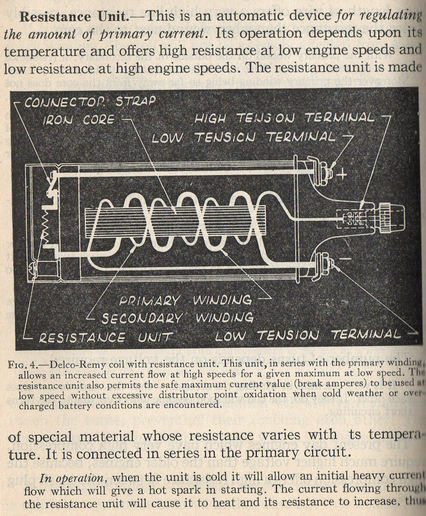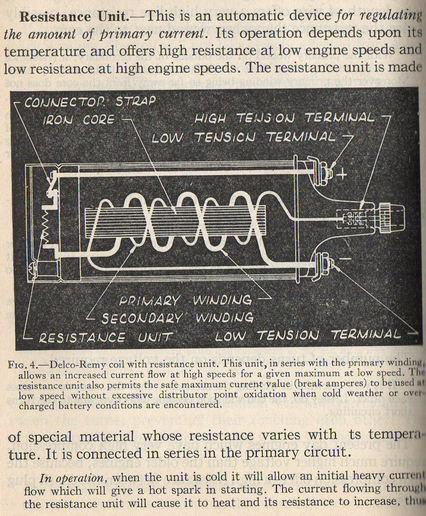You should upgrade or use an alternative browser.
- Thread starter bobgrimes
- Start date
Jim.ME
Well-known Member
- Location
- central ME
(quoted from post at 21:43:55 05/17/22) New coil is a 6 volt internal resistor. Not sure why you think it is a 12
What is the part number of the coil you purchased from Rock Auto?
1) A 12 volt tractor like yours came with a 6 volt coil PLUS a series voltage dropping (12 down to 6) ballast resistor and if you want to stay original and need a new coil .... you use a 6 volt coil wired the same. Typically a 6 volt coil HAS NO INTERNAL BALLAST.
2) If you don't want to use the voltage dropping (12 to 6) ballast resistor THEN YOU NEED A FULL TRUE 12 VOLT RATED COIL. If so the wire from the ignition switch to the ballast would be replaced with a wire from the same ignition switch terminal DIRECT TO THE COIL thereby by passing the voltage dropping ballast IE you need the full 12 volts on a 12 volt coil NOT have it reduced by the ballast !!!!!
FYI Typical old 12 Volt tractor coils DO NOT HAVE A DISCRETE STAND ALONE RESISITR TUCKED AWAY INSIDE THE CAN. Some call them INTERNALLY BALLASTED although actually there is NO INTERNAL BALLAST the necessary around 3 ohms of LV primary resistance comes solely by the windings resistance
SEEMS LIKE I POSTED THIS TWICE BEFORE but again to help:
A coil labeled 12 Volts for use with (or requires) external ballast IS IN REALITY MORE LIKE A 6 VOLT COIL and needs the ballast like it says or it will overheat !!!!
A coil labeled 6 volts has around 1.5 ohms of LV primary resistance and NO internal ballast
A coil labeled 12 Volts has around 3 ohms of LV primary resistance
YOUR SPECIFIC QUESTION
With an original 6 volt coil on a 12 volt tractor equipped with an external ballast PLUS a ballast by pass when starting feature but you change to a full true 12 volt coil (no ballast used) ............. THE WIRE FROM STARTER SWITCH up to the coil IS NO LONGER USED AND NEEDS TAPED OFF AND INSULATED AND PROTECTED OR TOTAL DISCONNECTED
There ya go I dont know what else to say lol by now you should be an EXPERT on those coils and how to change from a 6 to a 12 volt coil and ditch the ballast. The original 6 volt coil on a 12 volt tractor was to improve cold weather starting via the ballast by pass when cranking but you can get by fine without it BUT YOU NEED A FULL TRUE 12 VOLT COIL no more series ballast which would drop voltage down to 6
John T
Jim.ME
Well-known Member
- Location
- central ME
I need to see the part number of the 6 volt coil with an internal resistor you purchased so I can look at the specs, to answer that question. 6 volt coils are wound for 6 volt use, none have resistors in them as far as I know. I looked at Rock Auto and they show no such coil, as I read the descriptions of coils for a 1950 Chevrolet truck they have. It appears they do have a misprint and show one as 12 volt, but if you check the Delco numbers it replaces they are 6 volt numbers, just like the other 1950 truck coils they show.
I believe you got a plain old style 6 volt coil and it needs the ballast resistor and starting bypass wire to be proper on a 12 volt system.
You just posted
I wanted to remain original which from what I can determine was a 6 volt coil with an external resistor.
CORRECT It had a 6 volt coil and the external ballast resistor was to reduce the 12 battery volts down to 6 for a 6 volt coil
You just posted
My question was what would you do with that wire you went with a 6 volt coil with an internal resistor.
The answer I gave above was
THE WIRE FROM STARTER SWITCH up to the coil IS NO LONGER USED AND NEEDS TAPED OFF AND INSULATED AND PROTECTED OR TOTAL DISCONNECTED
If you re read my post above I think it answers all your questions but if not feel free to ask more
Best wishes now
John T
resistor. I have a 6 volt with an internal resistor. They are
common. I am waiting for the ordered one to arrive. I
wanted to know what to do with starter wire if I used the o
e without an external resistor. Probably not making
myself clear on this. When new coil(without resistor)
arrives I will use that
James Howell
Well-known Member
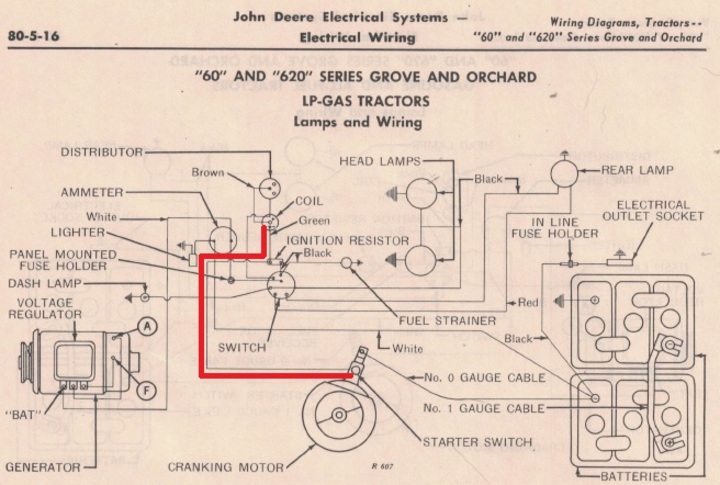
Note the original lead wire (color not specified) to the ignition resistor.
Pure speculation on my part, based on hearsay or old wives' tale, this original bypass wire was designed to provide more [i:654c4848f0]starting power[/i:654c4848f0] directly to the coil.
It only provided more [i:654c4848f0]starting power[/i:654c4848f0] when the starter switch was engaged.
You might consider attaching the lead wire (illustrated in red) from the starter switch to the NEGATIVE terminal on the coil.
Instead, you might also consider removing the lead wire from the starter switch.
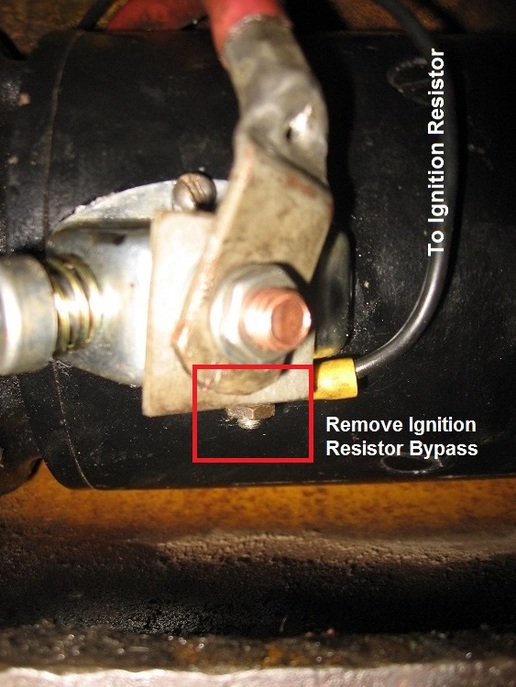
Hope this helps.
FYI
Pure speculation on my part, based on hearsay or old wives' tale, this original bypass wire was designed to provide more starting power directly to the coil.
Your speculation is indeed CORRECT, it's NOT an old wives' tale lol. The purpose of the by pass wire was to provide unballasted battery voltage direct to the coil when the starter was engaged. When not in place the voltage to the coil with the points closed was reduced due to the I x R drop across the ballast resistor, however, when the starter is engaged the ballast is effectively bypassed with battery voltage sent direct to the coil via that wire !!!!!!!!!!
It only provided more starting power when the starter switch was engaged.
EXACTLY if all the time there would be 12 volts on a 6 volt coil and it would overheat
Nice sparky chatting with you, best wishes keep them pictures coming
John T
wore out
Well-known Member
(quoted from post at 18:43:55 05/17/22) New coil is a 6 volt internal resistor. Not sure why you think it is a 12
"Not sure why you think it is a 12"
Conversely, I'm not sure why you would think your "6 Volt coil" has an internal resistor?????
wore out
Well-known Member
(quoted from post at 10:41:49 05/18/22) All the six volts carried by Napa etc are internal resistor. I
had to get one for a 1950 Chevy truck that had no
resistor.
"All the six volts carried by Napa etc are internal resistor."
Mr. Grimes, you are free to have your OPINION and to post it here, but that doesn't make it a "fact".
Rest assured there's NO "resistor" in a common, modern, 6 Volt ignition coil you bought at NAPA.
James Howell
Well-known Member
Thanks for the information.
[b:654c4848f0][i:654c4848f0]keep them pictures coming[/i:654c4848f0][/b:654c4848f0]
Take a look at the photos below.

Note the side terminal on the starter switch.
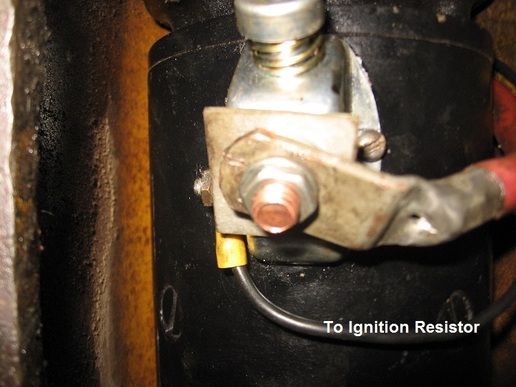
Note the black wire connected to the side terminal on the starter switch leading to the ignition resistor.

Note the black wire from the starter switch connected to the output terminal on the ignition resistor.
When you press down on the starter pedal, 12 volt power temporarily goes directly from the battery to the ignition resistor and coil at start up.
Take a look at the diagram below.

If the ignition switch is [b:654c4848f0]ON[/b:654c4848f0], then once you release the starter pedal, the power comes from the ignition switch to the ignition resistor and coil.
M-MAN
Well-known Member
- Location
- Bostic, NC
Technically they are right but realistically you are. All the ballast resistor is a different wire wound around the ceramic to drop the voltage. The no external resistor needed puts the extra wire inside the can to drop the voltage. Outside it's a resistor but inside its just magic. Clear as mud? Lol
Indeed the ONLY time the ballast by pass circuit functions is when the starter is engaged...
When the start switch is depressed the SMALL starter switch terminal sends unballasted battery voltage direct to the coil SO ITS NOT PASSING THROUGH THE BALLAST AND SUBJECT TO ITS (12 to 6) VOLTAGE DROP
When the ignition switch is on battery voltage is fed to the ballast and when the points are closed and the coil conducts current around 6 volts are dropped across the ballast leaving 6 volts for the 6 volt coil AGAIN HOWEVER ONLY when the start switch is depressed unballasted battery voltage (via the small black wire) is sent do the coil but its not subject to the 6 volt drop across the darn ballast !!! That is to improve cold weather starting when battery voltage can drop dramatically causing a weaker spark !!!
Now if we are helping and not confusing the original poster.....If so he can post questions
Fun sparky chatting with you, best wishes
John T
AGAIN they did make coils that indeed did have an internal resistor in the bottom of the can but I have NEVER SEEN OR HEARD of any on old farm tractors and I bet NAPA or Deere or IHC or TSC DO NOT STOCK ANY COILS WITH INTERNAL RESISTORS !!!!!!!
Fun sparky chatting with you I hope this helps
Best wishes now take care
John T
Jim.ME
Well-known Member
- Location
- central ME

A 12 volt coil that is properly wound for a 12 volt system will say "12 V NO EXTERNAL RESISTOR REQUIRED".

A 12 volt coil, wound as 6 volt but intended to be used on a 12 volt system, like your 620 which has an external resistor, would be labeled "12 V USE WITH EXTERNAL RESISTOR".

Straight 6 Volt,,, Straight 12 Volt,,,,,,,,,,,,And 12 Volt systems that used a 6 volt coil plus an external
series ballast with a ballast by pass when starting option
Those pictures should help the original poster
John T
Similar threads
- Replies
- 26
- Views
- 728
We sell tractor parts! We have the parts you need to repair your tractor - the right parts. Our low prices and years of research make us your best choice when you need parts. Shop Online Today.
Copyright © 1997-2024 Yesterday's Tractor Co.
All Rights Reserved. Reproduction of any part of this website, including design and content, without written permission is strictly prohibited. Trade Marks and Trade Names contained and used in this Website are those of others, and are used in this Website in a descriptive sense to refer to the products of others. Use of this Web site constitutes acceptance of our User Agreement and Privacy Policy TRADEMARK DISCLAIMER: Tradenames and Trademarks referred to within Yesterday's Tractor Co. products and within the Yesterday's Tractor Co. websites are the property of their respective trademark holders. None of these trademark holders are affiliated with Yesterday's Tractor Co., our products, or our website nor are we sponsored by them. John Deere and its logos are the registered trademarks of the John Deere Corporation. Agco, Agco Allis, White, Massey Ferguson and their logos are the registered trademarks of AGCO Corporation. Case, Case-IH, Farmall, International Harvester, New Holland and their logos are registered trademarks of CNH Global N.V.
Yesterday's Tractors - Antique Tractor Headquarters
Website Accessibility Policy


